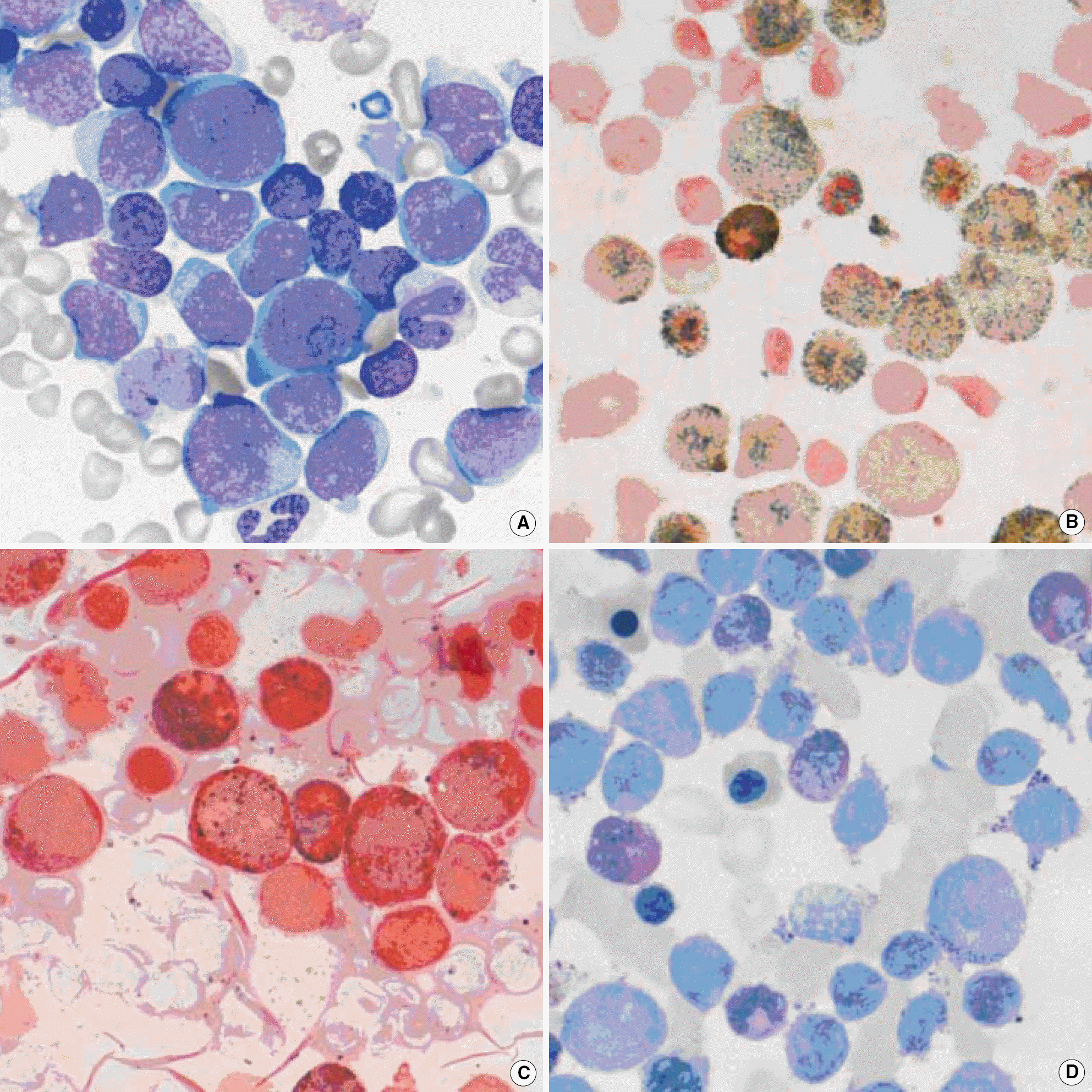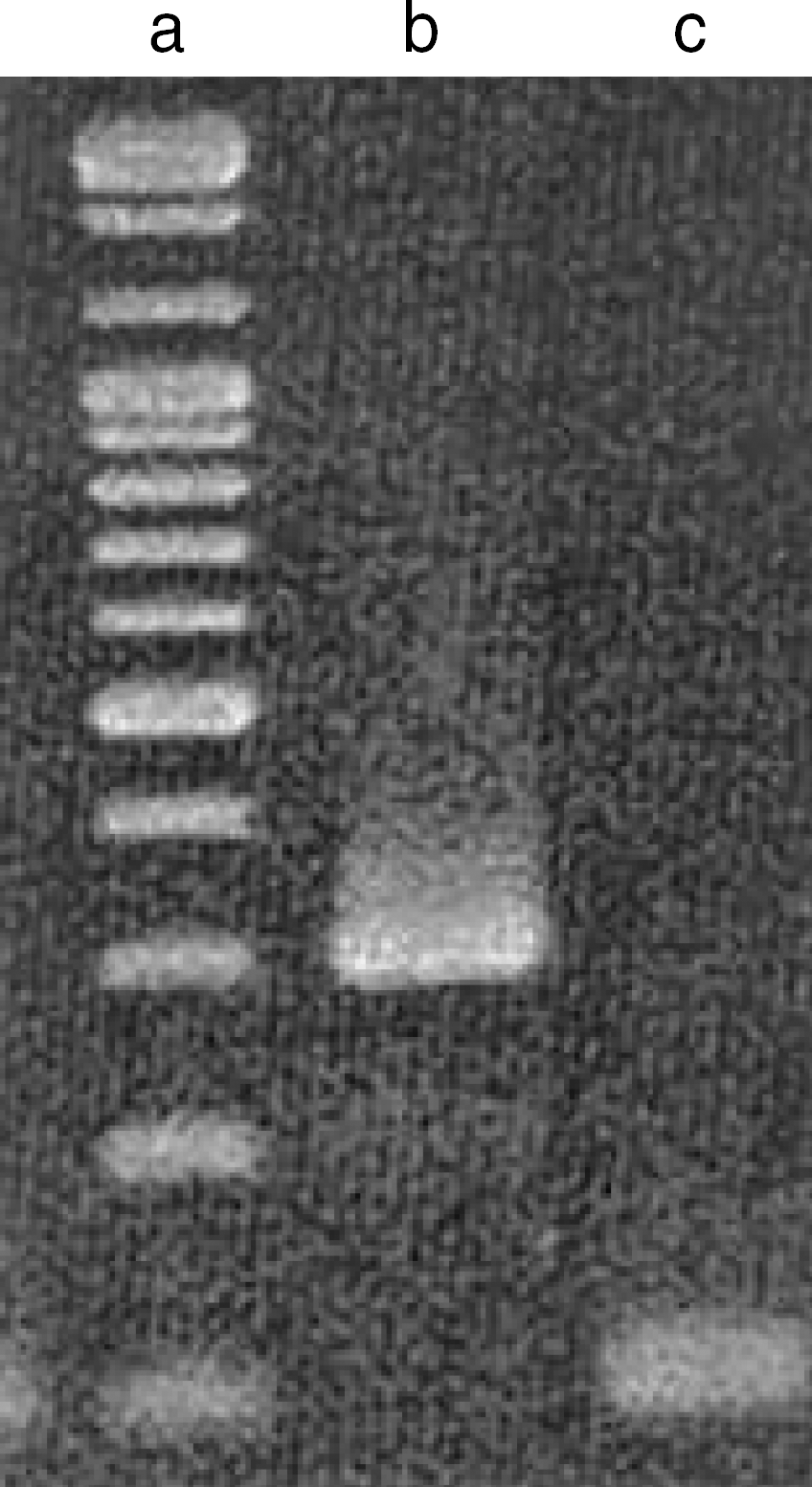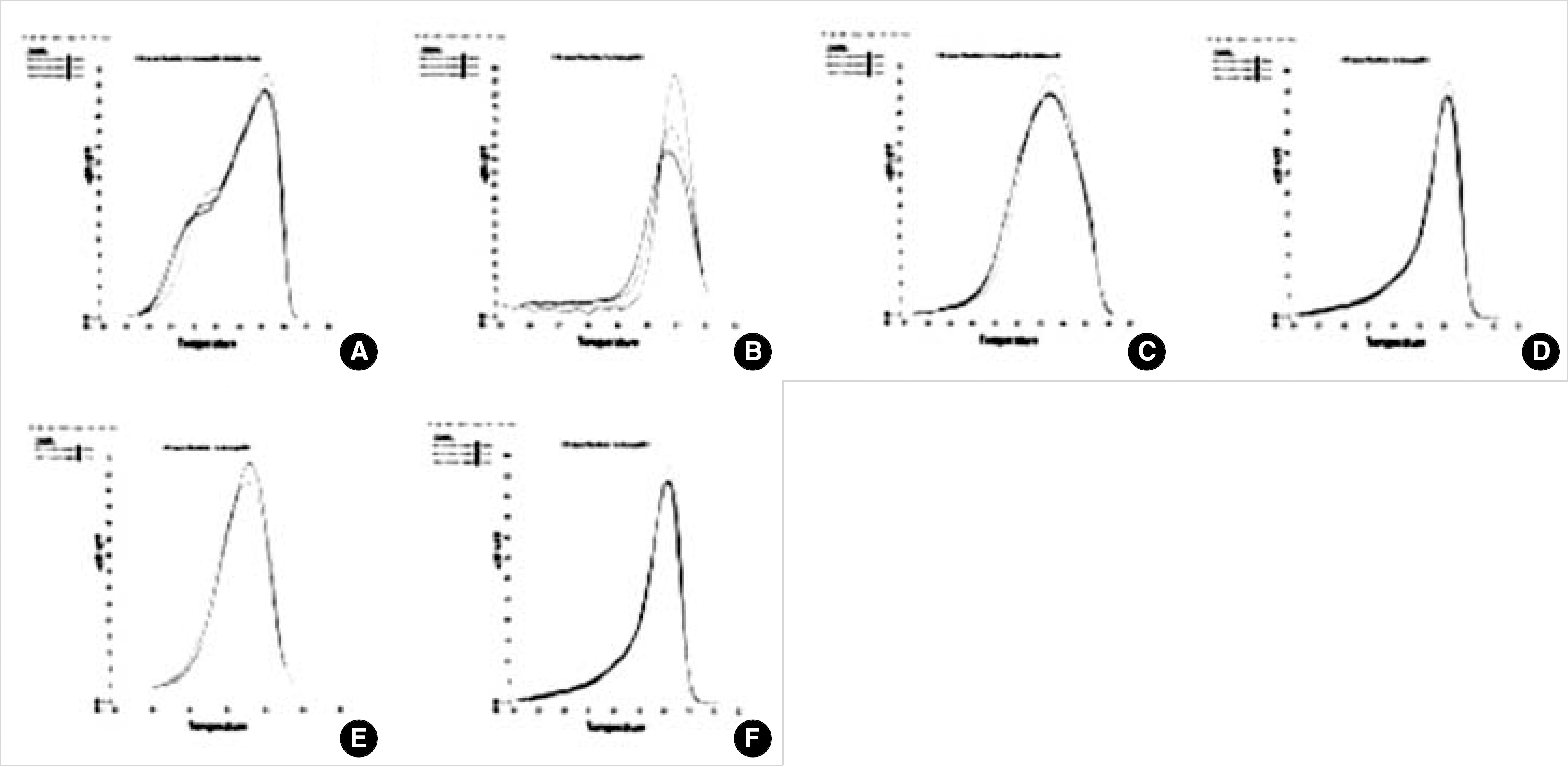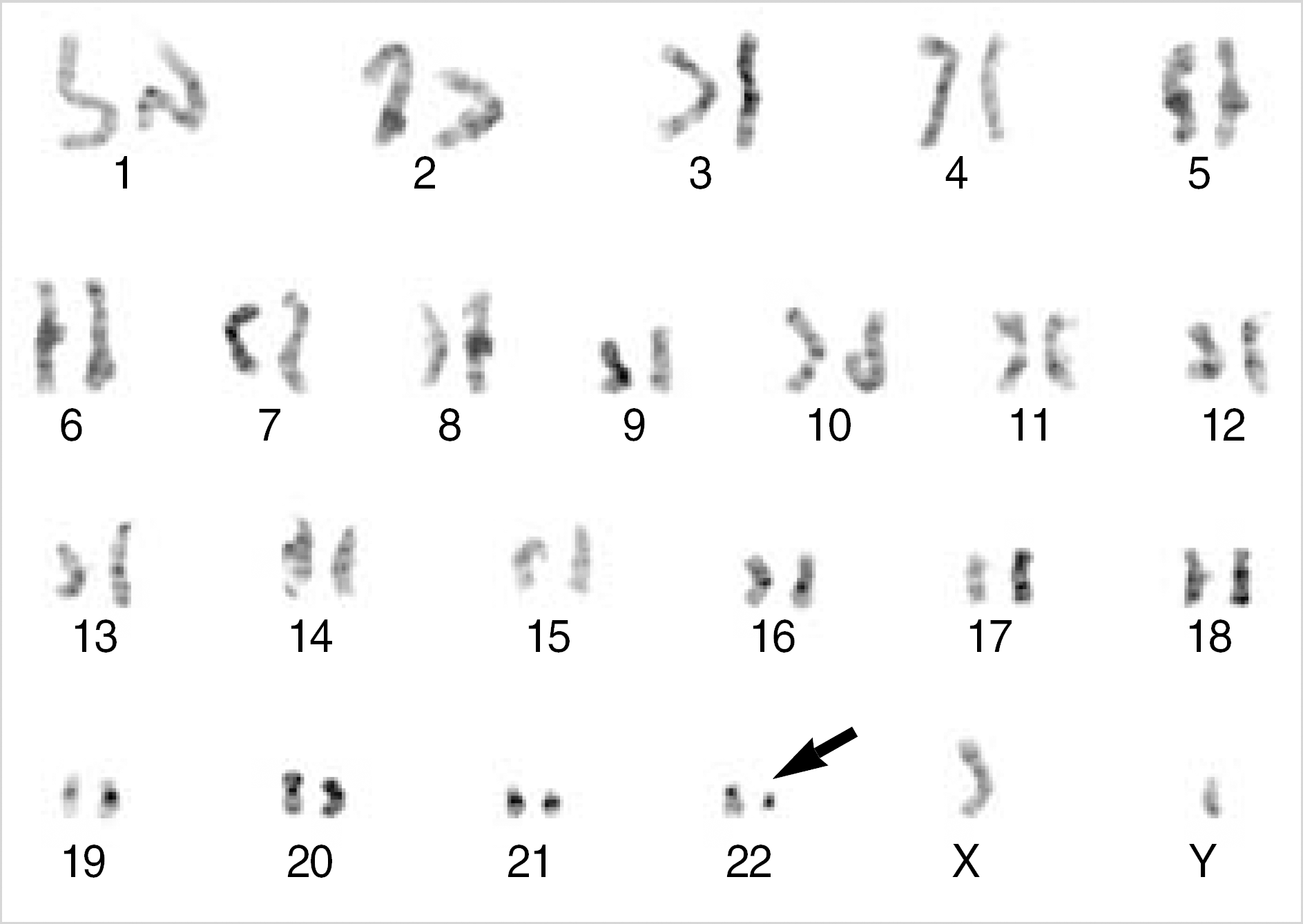Abstract
Biphenotypic acute leukemia (BAL) is a subtype of leukemia of ambiguous lineage in the World Health Organization classification system. About one third of the cases have the Philadelphia chromosome, and some cases are associated with other structural abnormalities involving 11q23. BAL is known to have a poor prognosis in both children and adults. According to the previously reported BAL cases with positive BCR-ABL fusion gene, most of the BCR-ABL mRNA transcript type was e1a2. So, we describe here a 30-year-old adult BAL case with the karyotype 46,XY,t(9;22)(q34;q11.2) resulting in a very rare b3a2 type of BCR-ABL mRNA transcript.
Go to : 
References
1. Frater JL, Yaseen NR, Peterson LC, Tallman MS, Goolsby CL. Biphenotypic acute leukemia with coexpression of CD79a and markers of myeloid lineage. Arch Pathol Lab Med. 2003; 127:356–9.

2. Brunning RD, Matutes E, Borowitz MJ, Flandrin G. Acute leukemias of ambiguous lineage. Vardiman JW, editor. Pathology and Genetics of Tumours of the Haematopoietic and Lymphoid Tissues. Lyon: IARC press;2001. p. 106–7.
3. Bene MC, Bernier M, Casasnovas RO, Castoldi G, Knapp W, Lanza F, et al. The reliability and specificity of c-kit for the diagnosis of acute myeloid leukemias and undifferentiated leukemias. The European Group for the Immunological Classification of Leukemias (EGIL). Blood. 1998; 92:596–9.
4. Carbonell F, Swansbury J, Min T, Matutes E, Farahat N, Buccheri V, et al. Cytogenetic findings in acute biphenotypic leukaemia. Leukemia. 1996; 10:1283–7.
5. Shin S, Park SS, Cho HI, Hur M, Lee YJ. Analysis of breakpoints of bcr-abl fusion gene using RT-PCR. Korean J Clin Pathol. 1999; 19:369–74.
6. Legrand O, Perrot JY, Simonin G, Baudard M, Cadiou M, Blanc C, et al. Adult biphenotypic acute leukaemia: an entity with poor prognosis which is related to unfavourable cytogenetics and P-glycoproteinover-expression. Br J Haematol. 1998; 100:147–55.
7. Mitelman F, editor. ISCN (1995) An International System for Human Cytogenetic Nomenclature. Basel: Karger;1995.
8. Kim KH, Han JY. Simultaneous Reverse Transcription-Polymerase Chain Reaction for detection of 7 gene rearrangement in acute leukemia. Korean J Clin Pathol. 2001; 21:24–33.
9. Matutes E, Morilla R, Farahat N, Carbonell F, Swansbury J, Dyer M, et al. Definition of acute biphenotypic leukemia. Haematologica. 1997; 82:64–6.
10. Killick S, Matutes E, Powles RL, Hamblin M, Swansbury J, Treleaven JG, et al. Outcome of biphenotypic acute leukemia. Haematologica. 1999; 84:699–706.
11. Lee MJ, Seo JJ, Park CJ, Chi HS, Moon HN, Ghim TT. Clinical characteristics of biphenotypic acute leukemia in childhood: A single institutional experience. Korean J Pediatr Hematol-Oncol. 2003; 10:49–57.
12. Cuneo A, Ferrant A, Michaux JL, Demuynck H, Boogaerts M, Louwagie A, et al. Philadelphia chromosome-positive acute myeloid leukemia: cytoimmunologic and cytogenetic features. Haematologica. 1996; 81:423–7.
13. Shepherd P, Suffolk R, Halsey J, Allan N. Analysis of molecular breakpoint and m-RNA transcripts in a prospective randomized trial of interferon in chronic myeloid leukaemia: no correlation with clinical features, cytogenetic response, duration of chronic phase, or survival. Br J Haematol. 1995; 89:546–54.

14. Russo C, Carroll A, Kohler S, Borowitz M, Amylon M, Homans A, et al. Philadelphia chromosome and monosomy 7 in childhood acute lymphoblastic leukemia: a Pediatric Oncology Group study. Blood. 1991; 77:1050–6.

15. Suryanarayan K, Hunger SP, Kohler S, Carroll AJ, Crist W, Link MP, et al. Consistent involvement of the bcr gene by 9;22 breakpoints in pediatric acute leukemias. Blood. 1991; 77:324–30.
16. Melo JV. The diversity of BCR-ABL fusion proteins and their relationship to leukemia phenotype. Blood. 1996; 88:2375–84.
17. Kawasaki ES, Clark SS, Coyne MY, Smith SD, Champlin R, Witte ON, et al. Diagnosis of chronic myeloid and acute lymphocytic leukemias by detection of leukemia-specific mRNA sequences amplified in vitro. Proc Natl Acad Sci USA. 1988; 85:5698–702.

18. Westbrook CA, Hooberman AL, Spino C, Dodge RK, Larson RA, Davey F, et al. Clinical significance of the BCR-ABL fusion gene in adult acute lymphoblastic leukemia: a Cancer and Leukemia Group B Study (8762). Blood. 1992; 80:2983–90.
19. Tanaka M, Yamazaki Y, Hattori M, Tsushita K, Utsumi M, Yoshida S. The dual expression of minor and major bcr/abl chimeric mRNA in blast crisis of chronic myelogenous leukemia. Leuk Res. 1996; 20:575–80.
20. Agirre X, Roman-Gomez J, Vazquez I, Jimenez-Velasco A, Larrayoz MJ, Lahortiga I, et al. Coexistence of different clonal populations harboring the b3a2 (p210) and e1a2 (p190) BCR-ABL1 fusion transcripts in chronic myelogenous leukemia resistant to imatinib. Cancer Genet Cytogenet. 2005; 160:22–6.
Go to : 
 | Fig. 1.Leukemic cell morphology and special stain. (A) Leukemic blasts were variable in size and morphology with small lymphoid like blasts and larger blasts having irregular nuclei, prominent nucleoli and abundant cytoplasm from bone marrow aspirate smear (Wright stain, × 1,000). (B) Positive reaction for myeloperoxidase stain (×1,000) and (C) sudan black B stain (×1,000). (D) Fine granular and diffuse positive reaction for periodic acid Schiff stain (×1,000). |
 | Fig. 3.Nested RT-PCR analysis for BCR/ABL chimeric mRNA disclosed b3a2 type (b, 305 bp), internal control of ABL gene (c, 105 bp) and marker (a, 100 bp ladder). |
 | Fig. 4.High resolution melter analysis for BCR-ABL fusion gene exon 5 (A), exon 7 (B), exon 8 (C), exon 9 (D), exon 10 (E) and exon 11 (F). The black curves are wild-type samples. The colored curves are patient's bone marrow samples, which showed no variations and identical melting curve pattern seen in wild type samples. |
Table 1.
PCR primers and conditions for melter analysis of ABL kinase domain
Table 2.
Summary of BCR-ABL mRNA transcript patterns from previously reported BAL cases and this case
| No. Case | Age | FAB | Karyotype | Transcript | Outcome |
|---|---|---|---|---|---|
| 1* | 64 | M0 | 46,XX,t(9;22)(q34;q11)[23] | b2a2 | Dead |
| 2* | 72 | L2 | 46,XX,-7,t(9;22)(q34;q11)[28] | e1a2 | Alive |
| 3* | 46 | L2 | 46,XX,t(9;22)(q34;q11)[31] | e1a2 | Dead |
| 4* | 49 | L2 | 46,XX,t(9;22)(q34;q11)[27] | e1a2 | Dead |
| 5* | 43 | L2 | 46,XX,t(9;22)(q34;q11)[36] | e1a2 | Dead |
| 6* | 43 | M1 | 46,XX,t(9;22)(q34;q11)[34] | e1a2, b2a2 | Alive |
| 7–11† | U | U | U | e1a2 (all) | U |
| 12‡ | 30 | 46,XY,t(9;22)(q34;q11)[20] | b3a2 | Alive |




 PDF
PDF ePub
ePub Citation
Citation Print
Print



 XML Download
XML Download